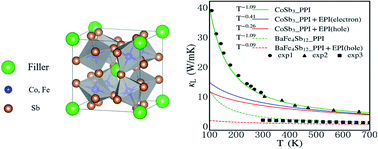Significant reduction in lattice thermal conductivity in a p-type filled skutterudite due to strong electron–phonon interactions†
Abstract
Electron–phonon interaction (EPI) has been widely suited in electrical transport properties. Nevertheless, its critical impact on the lattice thermal transport has been revealed in the last few years. Recently, people found that EPI can remarkably reduce the lattice thermal conductivity under a high carrier concentration and low temperature such as in silicon and two-dimensional materials; however, the discussions on thermoelectric (TE) materials are few. In this study, we investigate the EPI effect on the lattice thermal conductivities of skutterudites CoSb3 and p-type filled BaFe4Sb12. At 300 K with 1021 cm−3 carrier concentration, the lattice thermal conductivity of CoSb3 decreases from 10.7 W m−1 K−1 to 7.03 W m−1 K−1 (hole doping, reduction 34.3%) and 8.18 W m−1 K−1 (electron doping, reduction 23.6%), respectively, while that of BaFe4Sb12 decreases from 3.24 W m−1 K−1 to 1.14 W m−1 K−1 (5 × 1021 cm−3 for hole concentration) with a reduction of 64.8%. The significant EPI effect in BaFe4Sb12 is mainly due to the large density of states (DOS) and strong EPI strength. Our study reveals that EPI plays an important role in the lattice thermal conductivity of filled skutterudites, and it can further optimize their TE performances.



 Please wait while we load your content...
Please wait while we load your content...